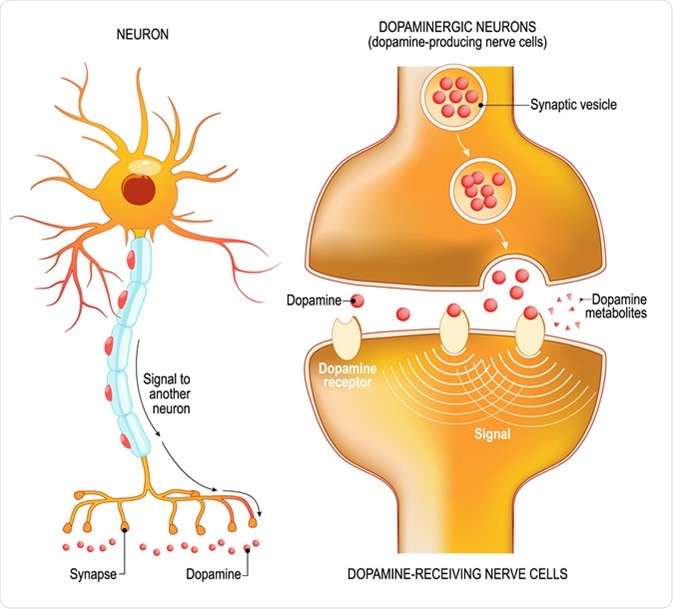
GABA Activation and Dopamine Suppression
The effects of dopamine in the reward pathway were first examined by Eugene Roberts in the 1970s in order to better understand the pathophysiology of schizophrenia. Subsequent research has gone a long way in helping us understand dopamine’s role within the mesolimbic system. A growing body of research is underway to examine the role of gamma aminobutyric acid (GABA) and dopamine within the mesolimbic system and the relationship between the two.
GABA, dopamine and the mesolimbic system
Learning about motivationally relevant stimuli within your surroundings is vital for survival. For example, such stimuli are essential to help meet the need for reproduction, feeding, and to avoid adverse or dangerous events. Such learning is coordinated by the mesolimbic system.
Commonly known as the reward system, the mesolimbic system comprises the nucleus accumbens (NAc) and ventral tegmental area (VTA) along with their associated efferent and afferent connections. Dopamine (DA) neurons have been largely thought to be responsible for signaling about the relevance of a stimulus, from the VTA to the NAc.

Dopamine. Closeup presynaptic axon terminal, synaptic cleft, and dopamine-receiving nerve and dopamine-producing cells. Labeled diagram. Illustration Credit: Designua / Shutterstock
Besides DA neurons, it is thought that approximately 30% of the VTA is comprised of γ-aminobutyric acid (GABA) neurons. It is understood that the inhibitory neurons can be differentiated into two subtypes: projection neurons which have an inhibitory effect across several regions of the brain including the NAc, and interneurons which inhibit local DA neurons. GABA’s inhibitory effects are important for the regulation of neuronal excitability.
GABA activation in the VTA
GABA’s role in the reward pathway has previously been less well understood. However, due to growing literature, there is a better understanding of the relationship between GABA and DA and their antagonist effects on human behavior. Specifically, research has found that the release of VTA GABA significantly influences the activity of dopamine neurons.
In mouse research, upon activation of GABA neurons in the VTA, a strong inhibitory effect was reported on the rate of firing in DA neurons. In contrast, following GABA neuron inhibition, a disinhibition or increase of dopamine was witnessed. These findings indicate that firstly, GABA activation could be associated with dopamine suppression, and secondly, that GABA neurons in the VTA may have a direct connection with the synapses of local DA neurons.
The putative mechanism underlying this relationship was highlighted by light-activation of GABA neurons that expressed ChR2. This induced an inhibitory postsynaptic response in nearby DA neurons. These disappeared following the use of picrotoxin or tetrodotoxin to block chloride or sodium channels, respectively. This response confirmed that the reflex pathway involved one synapse which was mediated by GABAA receptors. It is thought that local GABA neurons regulate their target DA neurons by activation of GABAA receptors, and as a result, decrease DA excitability, thus balancing excitatory glutamatergic inputs.
The effects of inhibitory control on DA function
GABA’s activity has vital consequences for dopamine function and subsequent behavior, especially those relating to outcomes that are motivationally relevant for the individual. It is suggested that the suppression of DA neurons in the VTA can occur when exposed to salient, yet unpleasant, stimuli. For example, electrical stimulation of the foot caused a short-lived increase in the activity of GABA neurons in the VTA but a decrease in the activity of DA neurons. However, this was found to be prevented by the use of a GABAA receptor antagonist, though not by dopamine antagonists. This effect was not observed, suggesting that increased GABAergic activity is required for it to occur.
Further research has confirmed that GABA neurons modulate VTA neuronal activity on behaviors that are motivationally relevant. Using a dynamic conditioned place aversion (CPA) paradigm, blue light was used to stimulate the VTA of mice infected with ChR2 while they explored one of two compartments. When the mice left the space, the area went dark.
During the experiment, they measured the level of aversion experienced while occupying the light paired-compartment when the VTA was subjected to no light. They found that the response produced upon activation of GABA neurons in the VTA persisted during the test sessions, suggesting that the inhibition of DA neurons produces a substantial learning effect.
This research indicates that activation of GABA neurons in the VTA may lead to the downregulation of DA neurons. Furthermore, it may suggest that GABA neurons in the VTA are involved in learned dysfunctional behavior, for example, those seen in individuals with addiction issues.
Overall, contemporary research has allowed better understanding of the intricate relationship between GABA activation and dopamine suppression in the reward pathway. More knowledge of these pathways and their consequences on human behavior could help us better understand the reward pathways operating in drug effects and drug addiction, among other areas.
Sources:
- Creed M. C., Ntamati N. R., & Tan K. R. (2014) VTA GABA neurons modulate specific learning behaviors through the control of dopamine and cholinergic systems. DOI: https://doi.org/10.3389/fnbeh.2014.00008
- Zessen R. V., Phillips J. L., Budygin E. A., et al. (2012). Activation of VTA GABA Neurons Disrupts Reward Consumption. DOI: https://doi.org/10.1016/j.neuron.2012.02.016
- Garbutt J. C., & van Kammen D. P. (1983). The interaction between GABA and dopamine: implications for schizophrenia. DOI: doi/10.1152/jn.1997.78.2.674
Further Reading
Last Updated: Jul 18, 2019
.jpg)





















.jpg)










No hay comentarios:
Publicar un comentario